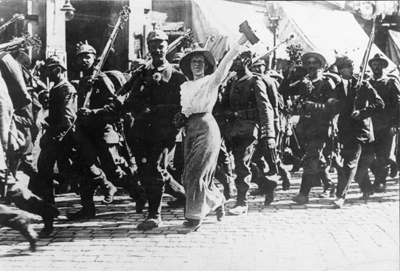The Archduke and his wife died together. It was their fourteenth wedding anniversary.
The Road to War
The assassination of Franz Ferdinand had very much been the work of Princip and his band of Black Hand conspirators but the Austrian–Hungarian empire saw an opportunity to assert its authority over Serbia. First it sought reassurance from its powerful ally, Germany. Together, they had formed the Dual Alliance in 1879 which, three years later, became the Triple Alliance when Italy added its signature. Now, the German Kaiser, Wilhelm II, gave Austria-Hungary the assurance it needed, then promptly went off on a cruise around Norway.
It took the Austrian–Hungarian government three weeks but the ultimatum they sent Serbia was, in the words of Britain’s foreign secretary, Sir Edward Grey, the ‘most formidable document ever sent from one nation to another’. Serbia was given forty-eight hours to comply with ten demands, specifically designed to humiliate and therefore be rejected. Although the Serbs agreed to eight, it was never going to be enough for the bellicose Austrian–Hungarians and on 28 July they declared war on Serbia.
Events now moved quickly, one triggering off another. In response to this declaration of war, Russia, which saw itself as protector of Serbia, began to mobilize. France, Russia’s ally since 1892, offered her its support. In response, the Germans gave Russia twelve hours to halt its mobilization. The deadline passed, thus on 1 August, Germany declared war on Russia and, two days later, on France. ‘The sword has been forced into our hand,’ claimed the Kaiser.
The Schlieffen Plan
Germany now faced a war on both its western and eastern borders; a war on two fronts. But it was a prospect they had long anticipated. In 1905, the then German Chief of Staff, Count Alfred von Schlieffen, had devised a plan for such an eventuality. Russia, he surmised, not incorrectly, would take up to six weeks to mobilize its armies, allowing Germany time to defeat France. In order to avoid the line of fortifications on the Franco-German border, the German army would have to advance through neutral Belgium in a huge sweeping movement: ‘let the last man on the right brush the Channel with his sleeve’. Having knocked out Belgium, it would swing south, covering twenty kilometres a day, and encircle Paris. Having dealt with the French, it would then have time to move east to confront the vast armies of Russia. Schlieffen died in 1913. One year later, his grand plan was put into action.
Speed was of the essence. On 2 August, Germany stormed through Luxembourg and demanded immediate access through Belgium. But ‘Poor little Belgium’, as the British press called her, refused and turned to a 1839 treaty, guaranteeing its neutrality. One of the signatories was Germany. The other was Great Britain. Britain asked Germany for an assurance that they would respect Belgium’s neutrality. Germany ignored it and on 4 August began bombing the city of Liège. Germany could not believe that Britain would go to war with a ‘kindred nation’ over a ‘scrap of paper’ – a treaty signed seventy-five years before. Britain declared war on Germany on 4 August. Sir Edward Grey, gazing out from the Foreign Office, remarked, ‘the lamps are going out all over Europe. We shall not see them lit again in our lifetime’.

The German army goes off to war, August 1914
Deutsches Bundesarchiv Bild 183-25684-0004
Grey, in his gloominess, was in a minority – the rest of Europe rejoiced at the prospect of war.
1 comment